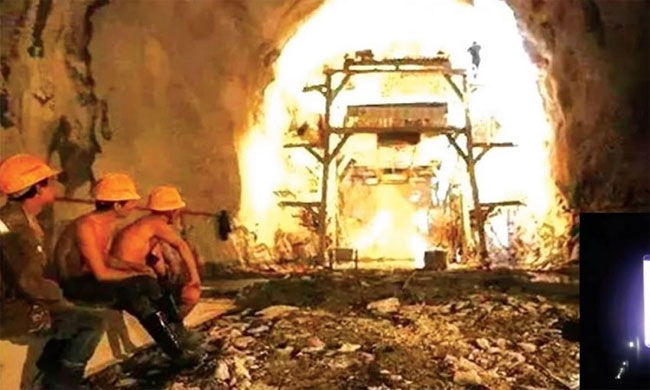The construction of the railway from Sichuan Province to Tibet must traverse areas with extremely high temperatures from the Earth’s crust.
Most of the railway line involves tunneling through rock layers that are so hot that neither humans nor machines can withstand them. There, ground temperatures can reach up to 89 degrees Celsius, a record high for a transportation infrastructure project, according to geologists.
As the Tibetan Plateau formed due to the collision between the Eurasian tectonic plate and the Indian subcontinent, tectonic forces led to the creation of the Himalayas, trapping a massive amount of heat within the elevated crust. The Sichuan-Tibet Railway, stretching 1,543 kilometers, crosses over 40 major fault lines, more than any previous railway project.

Workers endure high temperatures while working in the tunnel. (Photo: Southwest Jiaotong University).
“The heat source underground rises along the fault areas, creating localized thermal hotspots, leading to frequent geothermal disasters,” said geophysics professor Lan Hengxing and colleagues at the Institute of Geography and Natural Resources Research, in a study published last week in the journal Engineering Geology.
Scientists and engineers have devised several methods to mitigate the heat as workers carry out the project to meet the completion deadline in 2024. The railway connects Chengdu, a densely populated economic hub in the southwest, with Lhasa, the capital of Tibet. Currently, one-third of the railway has been completed, and trains are already in operation.
With a speed of 200 km/h, trains can reduce travel time to Tibet from a week to just 12 hours, although this is still slower than high-speed trains (350 km/h). This is due to the trains needing to ascend over 3,000 meters through some of the most remote and harshest terrains in the world, facing the impacts of earthquakes, landslides, floods, and melting glaciers.
The idea of building a railway from the fertile Sichuan Basin to Tibet was proposed nearly a century ago when traders took almost a year to travel on horseback. In 2014, the Chinese government launched the Sichuan-Tibet project with a 10-year timeline. Almost the entire route runs through bridges or tunnels. With eight peaks towering over 4,000 meters, civil engineers consider this the most challenging railway project in history.
Over 70% of workers reported health issues, the most common being chest pain, vomiting, and loss of consciousness due to high temperatures in the tunnels, according to a 2019 study by Professor He Chuan at Southwest Jiaotong University. Workers can only endure the high temperatures for two hours. The extreme heat also causes truck and bulldozer engines to overheat, while tires and brakes fail to function. However, the most dangerous situation is when rocks explode under high temperature and pressure, threatening all workers in the construction area.
There are over 70 tunnels along the railway, with the longest tunnel exceeding 40 kilometers. To reduce the temperature, engineers have installed enormous fans to blow cool air into the tunnels at a volume of 300 cubic meters per second. They also frequently spray cold water on the rocks to absorb heat. In areas requiring drilling, blocks of ice are stacked along the tunnel walls, sometimes weighing over 200 tons a day. “These methods have proven effective,” Lan stated. “As a result, the high geothermal risks associated with the Sichuan-Tibet Railway are generally under control.”


















































